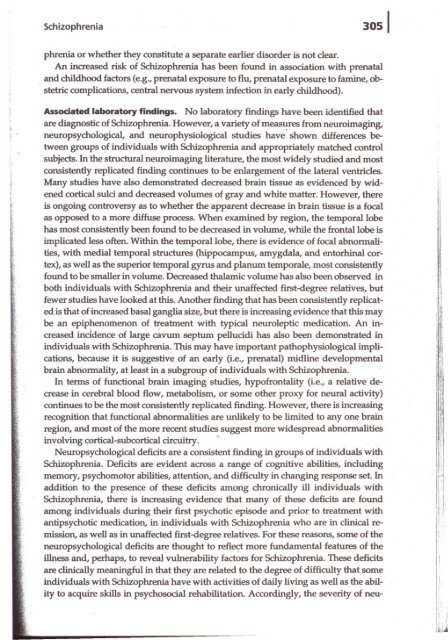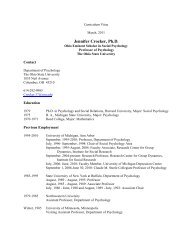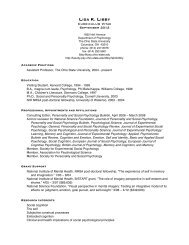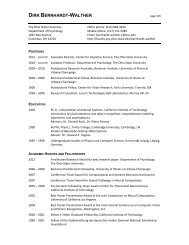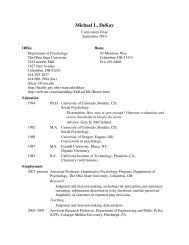Schizophrenia and Other Psychotic Disorders pg297-315.pdf
Schizophrenia and Other Psychotic Disorders pg297-315.pdf
Schizophrenia and Other Psychotic Disorders pg297-315.pdf
Create successful ePaper yourself
Turn your PDF publications into a flip-book with our unique Google optimized e-Paper software.
<strong>Schizophrenia</strong> 3051<br />
phrenia or whether they constitute a separate earlier disorder is not clear.<br />
An increased risk of <strong>Schizophrenia</strong> has been found in association with prenatal<br />
. <strong>and</strong> childhood factors (e.g., prenatal exposure to flu, prenatal exposure to famine,·obstetric<br />
complications, central nervous system infection in early childhood).<br />
Associated laboratory findings. No laboratory findings have been identified that<br />
are diagnostic of <strong>Schizophrenia</strong>. However, a variety of measures from neuroimaging,<br />
neuropsychological, .<strong>and</strong> neurophysiological studies have' shown differences between<br />
groups ,!f individuals with <strong>Schizophrenia</strong> <strong>and</strong> appropriately matched control<br />
subjects. In the structural neuroimaging literature, the most widely studied <strong>and</strong> most<br />
consistently replicated finding continues to be enlargement of the lateral ventricles.<br />
Many studies have also demonstrated decreased brain tissue as evidenced by widened<br />
cortical sulci <strong>and</strong> decreased volumes of gray <strong>and</strong> white matter. However, there<br />
is ongoing controversy as to whether the apparent decrease in brain tissue is a focal<br />
as opposed to a more diffuse pr~. When examined by region, the temporal lobe<br />
has most consistently been found to be decreased in volume, while the frontal lobe is<br />
implicated less often. Within the temporal lobe, there is evidence of focal abnormalities,<br />
with medial temporal structures (hippocampus, amygdala, <strong>and</strong> entorhinal eoi';.<br />
tex), as well as the superior temporal gyrus <strong>and</strong> planum temp orale, most consistently<br />
found to be smaller in volume. Decreased thalamic volume has also been observed in<br />
both individuals with <strong>Schizophrenia</strong> <strong>and</strong> their uDaffected first-degree relatives, but<br />
fewer studies have looked at this. Another finding that has been consistently replicated<br />
is that of increased basal ganglia size, but there is increasing evidence that this may<br />
be an epiphenomenon of treatment with typical neuroleptic medication. An" increased<br />
inddence of large ~vum septum pellucidi has also been demonstrated in<br />
individuals with <strong>Schizophrenia</strong>. This may have important pathophysiological implications,<br />
because it is suggestive of an early (i.e., prenatal) midline developmental<br />
brain abnormality, at least in a subgroup of individuals with <strong>Schizophrenia</strong>.<br />
In terms of functional brain imaging studies, hypofrontality (i.e., a relative decrease<br />
in cerebral blood flow, metabolism, or some other proxy for neural activity)<br />
continues to be the most consistently replicated finding. However, there is increasing<br />
. recognition that functional abnormalities are unlikely to be limited to anyone brain<br />
region, <strong>and</strong> most of the more recent studies suggest more widespread abnormalities<br />
involving cortical-subcortical circUitry ....<br />
. .Neuropsychological deficits are a consistent finding in groups of individuals with<br />
<strong>Schizophrenia</strong>. Deficits are evident across a range of cognitive abilities, including<br />
memory, psychomotor abilities, attention, <strong>and</strong> difficulty in changing response set. In<br />
addition to the presence of these deficits among d}ronically ill individuals with<br />
<strong>Schizophrenia</strong>, there is increasing evidence that many of these deficits are found<br />
among individuals during their first psychotic episode <strong>and</strong> prior to treatment with<br />
antipsychotic medication, in individuals with <strong>Schizophrenia</strong> who are in clinical remiSsion,<br />
as well as in unaffected first-degree relatives. For these reasons, some of the<br />
neuropsychological deficits are thought to refl~ more fundamental features of the<br />
illness <strong>and</strong>, perhaps, to reveal -vulnerability factors for <strong>Schizophrenia</strong>. These deficits<br />
are clinically meaningful in that they are related to the degree of difficulty that some<br />
individuals with <strong>Schizophrenia</strong> have with activities .o~daily living as well as the abil~<br />
ity to acqUire skills in psychosocial rehabilitation. Accordingly, the severity of neu-


